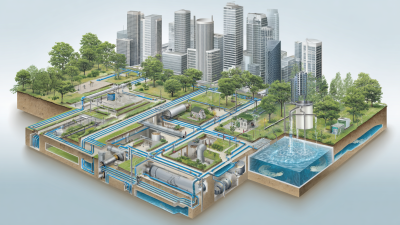Exploring the Essential Role of Water Systems in Sustainable Urban Development and Climate Resilience
As urban areas continue to expand and climate challenges intensify, the role of water systems in fostering sustainable urban development and enhancing climate resilience has never been more critical. According to the United Nations, over 55% of the global population currently lives in urban areas, a figure projected to reach 68% by 2050. This rapid urbanization places unprecedented pressure on water resources, making effective water management essential. A report by the World Resources Institute indicates that nearly 80% of the world's population is projected to live in areas facing water scarcity by 2025. Sustainable water systems not only provide essential services but also contribute to the mitigation of climate change impacts through improved flood management, efficient resource allocation, and ecosystem preservation. Recognizing and investing in these vital infrastructures can dramatically reshape urban landscapes, ensuring that cities remain resilient and livable in the face of emerging environmental challenges.

Understanding the Interconnection Between Water Systems and Urban Sustainability
Water systems are a fundamental component of urban sustainability, serving as the backbone for efficient resource management and environmental protection. They facilitate the functioning of cities by providing essential services such as drinking water supply, wastewater management, and stormwater control. These systems not only help to maintain public health but also support economic activities and enhance the overall quality of urban life. By integrating green infrastructure, such as permeable pavements and green roofs, cities can improve water retention and reduce runoff, thereby promoting sustainable water use while mitigating the impacts of flooding and pollution.
Moreover, the interconnection between water systems and climate resilience is increasingly recognized in urban planning. As cities face rising temperatures and extreme weather events, resilient water systems become crucial for adapting to changing climatic conditions. Implementing sustainable practices such as water recycling and rainwater harvesting can reduce dependency on external water sources, ensuring a more secure supply. Additionally, effective water management contributes to the overall ecological health of urban areas, supporting biodiversity and reducing urban heat islands. By prioritizing the integration of resilient water systems, cities can not only enhance their sustainability efforts but also improve their capacity to withstand and adapt to climate challenges.
Assessing Current Water Management Practices in Urban Areas
Rapid urbanization in regions facing water scarcity presents a significant challenge to achieving the United Nations Sustainable Development Goals (SDGs). As urban populations swell in these areas, the demand for water is increasing, highlighting the inadequacies in current water management practices. Research by Professor He Chunyang from Beijing Normal University underscores that without effective strategies to assess and improve water availability and management, the sustainability of urban development will be jeopardized.
Innovative approaches, such as the transformation of wastewater treatment plants into rainwater retention facilities, are being implemented in cities like Shanghai. This dual-purpose infrastructure not only enhances local water management but also demonstrates how urban areas can adapt to environmental challenges through sustainable practices. Furthermore, recent conferences among global scientists and local leaders emphasize the importance of a coordinated research agenda to address the intersection of urban resilience and climate change, advocating for comprehensive, data-driven solutions to enhance water systems in rapidly growing urban centers.
Water Management Practices in Urban Areas
Innovative Solutions for Enhancing Urban Water Resilience
Innovative solutions are vital for enhancing urban water resilience, particularly in the face of climate change and rapid urbanization. One promising approach involves the integration of green infrastructure, such as rain gardens, permeable pavements, and green roofs, which can effectively manage stormwater and reduce flooding. These systems not only mitigate the impact of heavy rainfall but also improve the urban landscape by providing recreational spaces and enhancing biodiversity. By allowing water to infiltrate naturally into the ground, cities can recharge their aquifers and decrease the burden on traditional drainage systems.
Another innovative method is the implementation of smart water management technologies. Utilizing sensors and data analytics can help municipalities monitor water quality and usage patterns in real time, enabling more efficient resource allocation and timely responses to leaks or contamination. Additionally, public engagement initiatives that educate residents on water conservation techniques can create a sense of community ownership over local water resources. By combining green infrastructure with advanced technologies, cities can build a more resilient water system that is prepared for the challenges posed by climate change.
Exploring the Essential Role of Water Systems in Sustainable Urban Development and Climate Resilience
| Dimension | Description | Examples of Innovative Solutions | Impact on Urban Resilience |
|---|---|---|---|
| Water Conservation | Strategies to reduce water usage through efficiency and recycling. | Smart water meters, rainwater harvesting systems. | Decreases demand and enhances supply reliability. |
| Stormwater Management | Utilization of infrastructure to manage surface runoff. | Permeable pavements, bioswales. | Reduces flooding risks and improves water quality. |
| Water Quality Improvement | Ensuring clean water through filtration and treatment. | Advanced filtration systems, green infrastructure. | Promotes public health and ecosystem integrity. |
| Community Engagement | Involving communities in water management decisions. | Workshops, citizen science projects. | Increases awareness and fosters stewardship. |
| Climate Adaptation | Adjusting water systems to meet changing climate conditions. | Climate-resilient infrastructure, drought-tolerant landscaping. | Enhances the capacity to withstand extreme weather events. |
Integrating Green Infrastructure into Urban Water Systems
Integrating green infrastructure into urban water systems is a crucial strategy for enhancing sustainability and climate resilience in urban environments. According to the U.S. Environmental Protection Agency (EPA), incorporating green infrastructure can reduce stormwater runoff by up to 65%, significantly mitigating flooding risks and improving water quality. This approach not only optimizes water management but also promotes biodiversity and enhances urban green spaces, creating healthier and more livable cities.
Moreover, a report by the World Resources Institute highlights that cities adopting green infrastructure can save up to 47% in costs compared to traditional grey stormwater systems. Features like green roofs, permeable pavements, and rain gardens are effective in capturing and reusing rainwater, reducing the burden on municipal systems. As urban areas continue to grow, integrating these solutions is essential for safeguarding water resources and ensuring equitable access to clean water.
**Tips:** To effectively integrate green infrastructure into urban planning, involve local communities in the design process. Engaging citizens not only fosters a sense of ownership but also helps identify the unique water management needs of the area. Additionally, consider implementing policies that incentivize property owners to adopt sustainable practices, such as tax breaks for installing rainwater harvesting systems.

Engaging Communities in Sustainable Water Use and Climate Adaptation
Engaging communities in sustainable water use and climate adaptation is critical for fostering resilience in urban environments. As the global population expands, the effective management of water resources becomes increasingly vital not just for sustaining local ecosystems, but also for supporting economic development. Community-driven initiatives, such as volunteer programs in Africa, have demonstrated how local champions can advocate for sustainable water practices and monitor resources effectively. These grassroots movements not only enhance water security but also empower residents to take an active role in their environmental stewardship.

Moreover, international organizations are recognizing the importance of community engagement in climate adaptation efforts. For instance, projects like urban river restoration in Japan have shown that when communities are involved, they cultivate a sense of ownership over their environment, leading to more effective climate action. Initiatives in Jordan highlight the role of young leaders and women in driving equitable climate responses, illustrating how inclusive strategies can lead to improved resilience. By prioritizing community participation in sustainable water management, cities can better prepare for and adapt to the increasing challenges posed by climate change.
Related Posts
-

Transform Your Life with the Ultimate Water System: Discover Healthier Hydration Today!
-

Innovative Water Treatment Systems for Sustainable Solutions in Your Home
-

Innovative Water System Solutions for Sustainable Urban Development
-

Unlocking the Future: How Water Reclamation Systems Can Revolutionize Urban Sustainability
-

Essential Guide to Understanding Water System Plumbing for Modern Homes
-

Understanding the Importance of a Reliable Water Testing System for Safe Drinking Water
